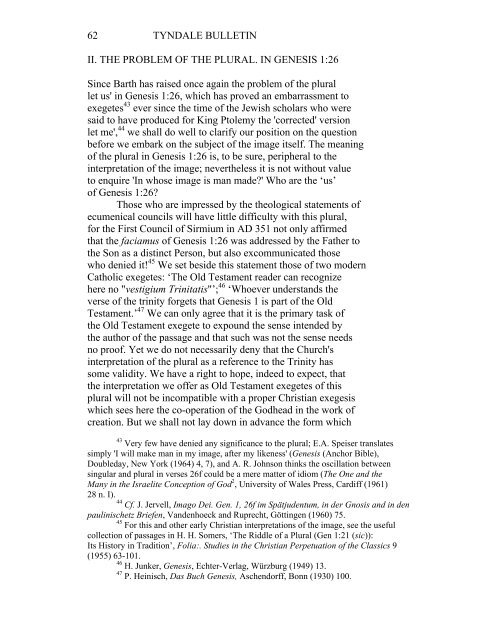THE IMAGE OF GOD IN MAN - Tyndale House
THE IMAGE OF GOD IN MAN - Tyndale House
THE IMAGE OF GOD IN MAN - Tyndale House
- TAGS
- tyndale
- tyndalehouse.com
You also want an ePaper? Increase the reach of your titles
YUMPU automatically turns print PDFs into web optimized ePapers that Google loves.
62 TYNDALE BULLET<strong>IN</strong><br />
II. <strong>THE</strong> PROBLEM <strong>OF</strong> <strong>THE</strong> PLURAL. <strong>IN</strong> GENESIS 1:26<br />
Since Barth has raised once again the problem of the plural<br />
let us' in Genesis 1:26, which has proved an embarrassment to<br />
exegetes 43 ever since the time of the Jewish scholars who were<br />
said to have produced for King Ptolemy the 'corrected' version<br />
let me', 44 we shall do well to clarify our position on the question<br />
before we embark on the subject of the image itself. The meaning<br />
of the plural in Genesis 1:26 is, to be sure, peripheral to the<br />
interpretation of the image; nevertheless it is not without value<br />
to enquire 'In whose image is man made?' Who are the ‘us’<br />
of Genesis 1:26?<br />
Those who are impressed by the theological statements of<br />
ecumenical councils will have little difficulty with this plural,<br />
for the First Council of Sirmium in AD 351 not only affirmed<br />
that the faciamus of Genesis 1:26 was addressed by the Father to<br />
the Son as a distinct Person, but also excommunicated those<br />
who denied it! 45 We set beside this statement those of two modern<br />
Catholic exegetes: ‘The Old Testament reader can recognize<br />
here no "vestigium Trinitatis"’; 46 ‘Whoever understands the<br />
verse of the trinity forgets that Genesis 1 is part of the Old<br />
Testament.’ 47 We can only agree that it is the primary task of<br />
the Old Testament exegete to expound the sense intended by<br />
the author of the passage and that such was not the sense needs<br />
no proof. Yet we do not necessarily deny that the Church's<br />
interpretation of the plural as a reference to the Trinity has<br />
some validity. We have a right to hope, indeed to expect, that<br />
the interpretation we offer as Old Testament exegetes of this<br />
plural will not be incompatible with a proper Christian exegesis<br />
which sees here the co-operation of the Godhead in the work of<br />
creation. But we shall not lay down in advance the form which<br />
43 Very few have denied any significance to the plural; E.A. Speiser translates<br />
simply 'I will make man in my image, after my likeness' (Genesis (Anchor Bible),<br />
Doubleday, New York (1964) 4, 7), and A. R. Johnson thinks the oscillation between<br />
singular and plural in verses 26f could be a mere matter of idiom (The One and the<br />
Many in the Israelite Conception of God 2 , University of Wales Press, Cardiff (1961)<br />
28 n. I).<br />
44 Cf. J. Jervell, Imago Dei. Gen. 1, 26f im Spätjudentum, in der Gnosis and in den<br />
paulinischetz Briefen, Vandenhoeck and Ruprecht, Göttingen (1960) 75.<br />
45 For this and other early Christian interpretations of the image, see the useful<br />
collection of passages in H. H. Somers, ‘The Riddle of a Plural (Gen 1:21 (sic)):<br />
Its History in Tradition’, Folia:. Studies in the Christian Perpetuation of the Classics 9<br />
(1955) 63-101.<br />
46 H. Junker, Genesis, Echter-Verlag, Würzburg (1949) 13.<br />
47 P. Heinisch, Das Buch Genesis, Aschendorff, Bonn (1930) 100.

















